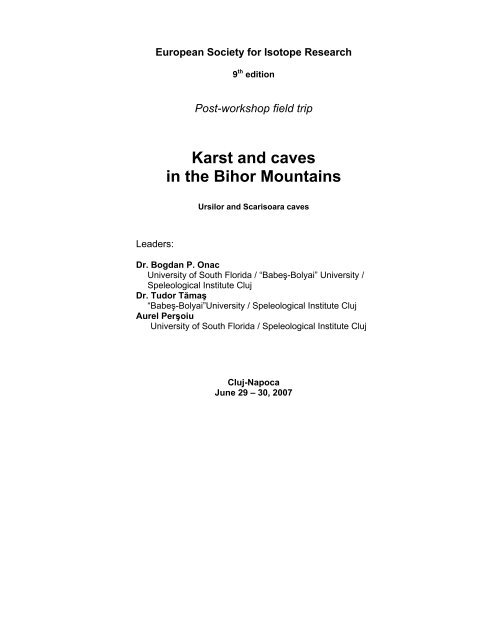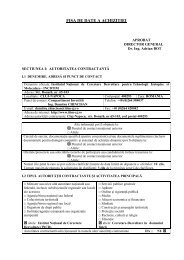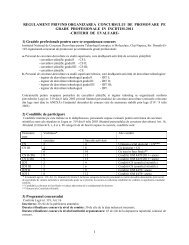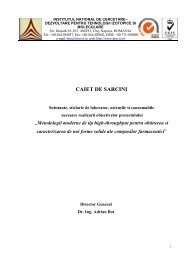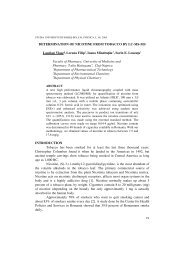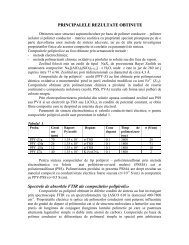Karst and caves in the Bihor Mountains - ITIM
Karst and caves in the Bihor Mountains - ITIM
Karst and caves in the Bihor Mountains - ITIM
- No tags were found...
Create successful ePaper yourself
Turn your PDF publications into a flip-book with our unique Google optimized e-Paper software.
European Society for Isotope Research9 th editionPost-workshop field trip<strong>Karst</strong> <strong>and</strong> <strong>caves</strong><strong>in</strong> <strong>the</strong> <strong>Bihor</strong> Mounta<strong>in</strong>sUrsilor <strong>and</strong> Scarisoara <strong>caves</strong>Leaders:Dr. Bogdan P. OnacUniversity of South Florida / “Babeş-Bolyai” University /Speleological Institute ClujDr. Tudor Tămaş“Babeş-Bolyai”University / Speleological Institute ClujAurel PerşoiuUniversity of South Florida / Speleological Institute ClujCluj-NapocaJune 29 – 30, 2007
Scărişoara – Ocoale regionThe Ocoale - Gheţar - Dobreşti karst system (<strong>in</strong>clud<strong>in</strong>gScărişoara Ice Cave) is part of <strong>the</strong> Scãrişoara karstcomplex, located <strong>in</strong> <strong>the</strong> central area of <strong>the</strong> <strong>Bihor</strong> Massif (<strong>the</strong>core unit of <strong>the</strong> Apuseni Mounta<strong>in</strong>s) known as <strong>the</strong> Gheţar –Ocoale Plateau.The morphologic <strong>and</strong> hydrologic elements of <strong>the</strong> areaallow <strong>the</strong> separation of three relief units: <strong>the</strong> Gârda SeacăValley, <strong>the</strong> Ordâncuşa Valley <strong>and</strong> <strong>the</strong> divide between <strong>the</strong>m.On this are dist<strong>in</strong>guished two subunits with clearly differentcharacteristics: The Scărişoara Plateau <strong>and</strong> <strong>the</strong> Ocoaleclosed bas<strong>in</strong>.The Gârda Seacă Valley spr<strong>in</strong>gs <strong>in</strong> Şesul Gârzii, atypical karst plateau over 20 km long. Downstream from <strong>the</strong>first spr<strong>in</strong>g, named Gura Apei, <strong>the</strong> river crosses twolimestone areas where it forms deep gorges, <strong>the</strong>ndisappears underground <strong>in</strong> <strong>the</strong> Coiba Mică Cave. Beyond<strong>the</strong> cave are <strong>the</strong> Cheile de la Coibe gorges with less steepwalls, <strong>and</strong> <strong>the</strong> valley widens until <strong>the</strong> Tăuz spr<strong>in</strong>g.Downstream from Tăuz, <strong>the</strong> valley has carved <strong>the</strong> mostimportant gorge sectors (Hoancele Căldărilor, Cheile de laCerbu, Cheile de sub Dealul Jilip, Cheile de la Tăuz) with<strong>the</strong> walls pierced by some tens of cave open<strong>in</strong>gs, most of<strong>the</strong>m very small.The Ordâncuşa Valley is considerably shorter, but itskarst l<strong>and</strong>scapes are more spectacular. Spr<strong>in</strong>g<strong>in</strong>g fromunder <strong>the</strong> Vârful Clujului (1399 m), <strong>the</strong> valley crosses <strong>in</strong> itsfirst part a less picturesque zone, but downstream it hascarved over 4 km some of <strong>the</strong> most impressive gorgesectors <strong>in</strong> <strong>the</strong> Apuseni Mounta<strong>in</strong>s, with walls ris<strong>in</strong>g <strong>in</strong> someplaces up to 200 m. To date, more than 100 <strong>caves</strong> havebeen discovered here, but most of <strong>the</strong>m are less than 50 mlong, <strong>the</strong> Zgurăşti Ice Cave <strong>and</strong> <strong>the</strong> Poarta lui Ionel <strong>caves</strong>be<strong>in</strong>g <strong>the</strong> exceptions. The ma<strong>in</strong> tributary of <strong>the</strong> Ordâncuşais <strong>the</strong> Pârâul Gheţarului, flow<strong>in</strong>g from Fântâna de la Iapa
<strong>and</strong> which dra<strong>in</strong>s <strong>the</strong> nor<strong>the</strong>astern part of <strong>the</strong> ScărişoaraPlateau.The divide between Gârda Seacă <strong>and</strong> Ordâncuşa is<strong>in</strong>dividualised as a unitary karst platform, ris<strong>in</strong>g at 300-400m above <strong>the</strong> neighbor<strong>in</strong>g valleys. Its sou<strong>the</strong>rn half has atypical plateau l<strong>and</strong>scape, while <strong>in</strong> <strong>the</strong> nor<strong>the</strong>rn half iscrossed by <strong>the</strong> Gheţar stream <strong>and</strong> <strong>the</strong> Ocoale Valley - <strong>the</strong>former with a permanent flow. To <strong>the</strong> north, <strong>the</strong> plateau isdom<strong>in</strong>ated by <strong>the</strong> l<strong>in</strong>e of Ocoale (1325 m) – Stânişoarei(1377 m) – Ordâncuşei (1358 m) hills, beyond which asuccession of o<strong>the</strong>r karst plateaus, namely <strong>the</strong> Muşunoaie– Vârtop – Şesul Gărzii – Căl<strong>in</strong>easa, l<strong>in</strong>k <strong>the</strong> divide to <strong>the</strong>Padiş Plateau, <strong>the</strong> au<strong>the</strong>ntic center of <strong>the</strong> <strong>Bihor</strong> Mounta<strong>in</strong>s.The Scărişoara Plateau is described by an alternanceof rounded limestone ridges <strong>and</strong> dol<strong>in</strong>e alignments, namedby <strong>the</strong> locals hârtoape. Its limit with <strong>the</strong> Ordâncuşa Valley isa 200 m limestone cliff, while its edge to <strong>the</strong> Gârda SeacăValley is a normal slope, specific to alp<strong>in</strong>e areas. Thedol<strong>in</strong>es are usually located above <strong>the</strong> ma<strong>in</strong> undergrounddra<strong>in</strong>ages <strong>and</strong> <strong>the</strong> water that <strong>in</strong>filtrates through <strong>the</strong>m arecollected by <strong>the</strong> Zgurăşti – Poarta lui Ionel <strong>and</strong> Ocoale –Gheţar – Dobreşti karst systems. The larger closeddepressions named uvalas, or jompuri <strong>in</strong> <strong>the</strong> moţi speech,of which <strong>the</strong> most representative is „Crapul” below TarniţăHill, were formed by <strong>the</strong> level<strong>in</strong>g of divides between severaldol<strong>in</strong>es. The only exokarst features where limestones risefrom <strong>the</strong> th<strong>in</strong> soil cover are various types of karren.The Ocoale closed bas<strong>in</strong> was modeled by <strong>the</strong> streamwith <strong>the</strong> same name between <strong>the</strong> Ocoale – Ordâncuşa hillridge to <strong>the</strong> north <strong>and</strong> <strong>the</strong> summit Culmea Pârjolii to <strong>the</strong>south. The Ocoale stream rises from below <strong>the</strong> Ocoale Hill(1324 m) by several spr<strong>in</strong>gs form<strong>in</strong>g a large marshy areadeveloped on impervious rocks. After a short subaerialpath, <strong>the</strong> water disappears underground through severalponors <strong>and</strong> diffuse losses scattered along some kilometers.In this f<strong>in</strong>al sector, <strong>the</strong> stream me<strong>and</strong>ers <strong>in</strong> a large
depression whose flat bottom is mostly flooded both dur<strong>in</strong>gheavy ra<strong>in</strong>s <strong>and</strong> at snow melt<strong>in</strong>g. The waters reappear at<strong>the</strong> surface at two different locations: Poliţei spr<strong>in</strong>g <strong>and</strong>Coteţul Dobreştilor resurgence.Downstream from <strong>the</strong> last ponor <strong>in</strong> <strong>the</strong> depression, <strong>the</strong>valley shape is hardly visible, but <strong>the</strong> old me<strong>and</strong>ers maystill be noticed. Then, after a short gorge sector beyond <strong>the</strong>well at Vuiagă <strong>the</strong> valley ends <strong>in</strong> a small ponor, <strong>in</strong> front of asteep cliff. On top of <strong>the</strong> cliff, <strong>in</strong> a large dol<strong>in</strong>e, opens <strong>the</strong>entrance shaft of <strong>the</strong> Şesuri Pothole. The dol<strong>in</strong>e is closed to<strong>the</strong> south by <strong>the</strong> Culmea Pârjolii, <strong>the</strong> massif which hosts <strong>the</strong>Scărişoara Ice Cave.The proper depression extends over 3.6 km 2 <strong>and</strong> isdom<strong>in</strong>ated by <strong>the</strong> Ocoale Hill to <strong>the</strong> north, <strong>the</strong> Comărnicel<strong>and</strong> Bocului hills to <strong>the</strong> west, Culmea Pârjolii to <strong>the</strong> south<strong>and</strong> Piatra Corbului hill to <strong>the</strong> east. Its sides are slop<strong>in</strong>ggently because subaerial streams quickly <strong>in</strong>filtrateunderground when <strong>the</strong>y cross karst areas <strong>and</strong> <strong>the</strong> reducedflowrates of <strong>the</strong> streams from <strong>the</strong> western <strong>and</strong> nor<strong>the</strong>rnedges cannot <strong>in</strong>duce erosion. The exokarst consists ofdol<strong>in</strong>es <strong>and</strong> numerous types of karren, of which <strong>the</strong> bestrepresented are <strong>the</strong> channel karren types.The geological sett<strong>in</strong>g of <strong>the</strong> Ocoale - Gheţar Plateau isra<strong>the</strong>r simple. The entire plateau is developed on Mesozoicsedimentary rocks belong<strong>in</strong>g to <strong>the</strong> <strong>Bihor</strong> Unit(autochthonous). To <strong>the</strong> west, <strong>the</strong> autochthonous isoverthrust by <strong>the</strong> Permian detrital formation developed <strong>in</strong> atypical Verrucano facies (purplish-red colored quartzites<strong>and</strong>stone, conglomerates, <strong>and</strong> shales). This latter one ispart of <strong>the</strong> Gârda Nappe.The existence of <strong>the</strong> Scărişoara Cave has stimulatedmany speleological <strong>in</strong>vestigations <strong>in</strong> <strong>the</strong> area. In particular,<strong>the</strong> water divide between Gârda Seacă <strong>and</strong> Ordâncuşavalleys, dom<strong>in</strong>ated by <strong>the</strong> Ocoale – Scărişoara closecatchment bas<strong>in</strong>, was <strong>the</strong> object of many observations.Among <strong>the</strong>se, groundwater flow directions <strong>and</strong> flow rate
values were measured <strong>in</strong> comb<strong>in</strong>ation with fluoresce<strong>in</strong>etracer tests (ORĂŞEANU, 1996).The Munună – Gheţar Fault, cross<strong>in</strong>g <strong>the</strong> plateau (N-S),is of crucial importance <strong>in</strong> <strong>the</strong> hydrogeology of this regionas it separate two dist<strong>in</strong>ct tectonic blocks (Fig. 3).Fig. 3. Hydrogeological map of <strong>the</strong> Gârda Seacă - Ordâncuşawater divide territory.
Legend: 1- Carbonate Mesozoic series (limestones <strong>and</strong> dolomites), highlyfractured <strong>and</strong> karstified, characterised by very high effective <strong>in</strong>filtration <strong>and</strong><strong>in</strong>tensive groundwater flow. Numerous karst systems with various size <strong>and</strong>prevelant b<strong>in</strong>ary type. Important water resources <strong>in</strong> large karst systems. 2-Unconsolidated Quaternary deposits with reduced water resources; 3-Mesozoicmolasse deposits with groundwater flow mostly conf<strong>in</strong>ed to <strong>the</strong> wea<strong>the</strong>r<strong>in</strong>g <strong>and</strong>fracture zones. Local importance; 4- Areas devoid of water resources; 5-(qh),recent alluvia. <strong>Bihor</strong> Autochthon: 6-(br+ap 1), undivided Urgonian limestones; 7–(th), black bedded oolithic limestones; 8-(ox-th 1), reef limestones; 9-(J 2), redoolithic limestones, yellowish spoted limestones, redish <strong>and</strong> grey encr<strong>in</strong>iticlimestones; 10- (si 2-to), redish <strong>and</strong> grey encr<strong>in</strong>itic limestones, marls; 11-(he+si 1),quartzitic s<strong>and</strong>stones <strong>and</strong> conglomerates, argillaceous shales, black limstones;12-(ld+cr 1), white reef limestones - Wetterste<strong>in</strong> limestone; 13-(an), grey dolomites.<strong>Bihor</strong> Autochthon <strong>and</strong> Gârda Nappe: 14-(w), quartzitic s<strong>and</strong>stones <strong>and</strong>conglomerates, red argillaceous shales; 15- Crystall<strong>in</strong>e schists; 16-Normalgeological boundary; 17-Discordant geological boundary; 18-Fault; 19-Overthrustfront; 20-Stream with perennial runoff; 21-Stream with temporary runoff; 22-<strong>Karst</strong>ic loss <strong>in</strong> river valley labelled with tracer; 23-Limit of <strong>in</strong>ternally dra<strong>in</strong>ed areas;24- Limit <strong>in</strong>side of <strong>in</strong>ternally dra<strong>in</strong>ed areas; 25-Village road; 26-Forest road; 27-Contour l<strong>in</strong>e; 28-Proved groundwater flow direction; 29-Direction ofhydrogeological cross section; 30-Perennial spr<strong>in</strong>g, discharge <strong>in</strong> l/s: a-under 1; b-1 to 10; c – 11 to 50; d: 200 to 350; 31-Temporary spr<strong>in</strong>g; 32-Dug well, perennialwater; 33-Dug well, temporary water; 34-Degass<strong>in</strong>g hypo<strong>the</strong>rmal spr<strong>in</strong>g; 35-Perennial outflow cave; 36-Temporary outflow cave; 37-Temporary <strong>in</strong>flow cave,tapp<strong>in</strong>g an underground stream; 38-Fossil cave; 39- Pothole tapp<strong>in</strong>g anunderground stream; 40-Fossil pothole; 41-Perennial swallet; 42-Temporaryswallet; 43-Meteorological station; 44-<strong>Karst</strong> depression, dol<strong>in</strong>e; 45-Cavepassage; 46-Hill.Key of <strong>the</strong> numbers: 1-Peştera cu Apă cave from Brustur brook; 2-Spr<strong>in</strong>g ofBăii brook; 3-Big ponor from La Hoape (Muşuroaie); 4-Ştiubei spr<strong>in</strong>g; 5-Tăuzspr<strong>in</strong>g; 6-Spr<strong>in</strong>g from Podul Cerbului; 8-Gârjel (La Ţâraie) spr<strong>in</strong>g; 9-Hoanca Apeispr<strong>in</strong>g <strong>and</strong> cave; 10-Peştera cu Apă cave from La Tău (Codobana); 11-PojarulPoliţei cave; 12-Poliţei spr<strong>in</strong>g; 13-Dobra’s spr<strong>in</strong>g; 14-Spr<strong>in</strong>g <strong>and</strong> cave from CoteţulDobreştilor; 15-Mill’s spr<strong>in</strong>g; 16-Feredeu spr<strong>in</strong>g; 17-Negreştilor dug well; 18-Jimboieşti (La Cârceni) dug well; 19-Ponor from Trei Cărări (Aprozar); 20-Ţuţerilorspr<strong>in</strong>g; 21-Debii spr<strong>in</strong>g; 22-Oncheştilor dug well <strong>and</strong> spr<strong>in</strong>g; 23-Costenilor spr<strong>in</strong>g;24-Buleştilor dug well; 25- Maciura dug well; 26-„Izbucul” from Dealul Brăzdeştilorspr<strong>in</strong>g; 27-Ponor of Gogului brook; 28-„La Izvoare” spr<strong>in</strong>g; 29-Mii spr<strong>in</strong>g; 30-Groapa cu Apă a lui Miron ponor; 31-Miron’s dug wel; 32-Ilii Florea’s dug well; 33-„Apa Rece” dug well; 34-Fântâna de După Deal dug well; 35- Spr<strong>in</strong>g <strong>and</strong> ponor atVuiaga Veche; 36-Dug well at Vuiagă; 37-Dug well at Şesuri; 38-Pothole atŞesuri; 39-Gheţarul de la Scărişoara ice cave; 40-Troaca spr<strong>in</strong>g; 41-Bărâcia dugwell; 42-„Apa d<strong>in</strong> Cale” dug well; 43-Dug well from Gard de la Dubi; 44- Potholefrom Pociocişte; 45-Pusta pothole; 46-Old dug well <strong>and</strong> spr<strong>in</strong>g from Dăgârţeşti;47-Bolf spr<strong>in</strong>g; 49-Gheţarului spr<strong>in</strong>g; 50-Iapa spr<strong>in</strong>g; 51-Losses <strong>in</strong> flow ofOrdâncuşa brook from Moara lui Ivan (Ivan’s mill); 52-Spr<strong>in</strong>g from Moara lui Chipa(Chipa’s mill); 53-Ţeghe spr<strong>in</strong>g; 54-Poarta lui Ioanele cave; 55-Zgurăşti cave.
Each block conta<strong>in</strong>s is own karst aquifer <strong>and</strong> resurgentspr<strong>in</strong>g. Waters enter<strong>in</strong>g <strong>the</strong> aquifer on <strong>the</strong> eastern side of<strong>the</strong> fault (Munună – Hănăşeşti Block) resurge out <strong>in</strong> Poartalui Ioanele spr<strong>in</strong>g (average flow rate 90 l/s). However,recent dye tracer mark<strong>in</strong>gs have shown that part of <strong>the</strong>sewaters are dra<strong>in</strong>ed towards west, cross<strong>in</strong>g <strong>the</strong> fault l<strong>in</strong>e,<strong>and</strong> flow<strong>in</strong>g out through <strong>the</strong> Coteţul Dobreştilor spr<strong>in</strong>g. On<strong>the</strong> western side of <strong>the</strong> fault (Ocoale Block) waters enter<strong>in</strong>g<strong>the</strong> aquifer are dra<strong>in</strong>ed by <strong>the</strong> Coteţul Dobreştilor spr<strong>in</strong>g.This latter dra<strong>in</strong>age is <strong>the</strong> longest (2800 m) <strong>and</strong> it has <strong>the</strong>largest relief (390 m) recorded <strong>in</strong> <strong>the</strong> Upper Arieşul MareBas<strong>in</strong>. It dra<strong>in</strong>s <strong>the</strong> waters of Ocoale rivulet that s<strong>in</strong>k with<strong>in</strong><strong>the</strong> Ocoale - Scărişoara close catchment bas<strong>in</strong>(ORĂŞEANU, 1996). The average flow rate recorded for<strong>the</strong> Coteţul Dobreştilor spr<strong>in</strong>g between October 1984 <strong>and</strong>September 1985 was 280 l/s. A flow volume of 1.06 m 3 /swas <strong>the</strong> monthly maximum. Dur<strong>in</strong>g periods of prolongdraught <strong>the</strong> spr<strong>in</strong>g flow rate decl<strong>in</strong>es progressively untilcomplete dry. The Coteţul Dobreştilor outlet is actually anoverflow spr<strong>in</strong>g of <strong>the</strong> system. The lowermost outlet isIzbucul Morii, located some 100 m downstream fromCoteţul Dobreştilor, as well as a number of spr<strong>in</strong>gs thatoccur nearby. These spr<strong>in</strong>gs (<strong>in</strong>clud<strong>in</strong>g <strong>the</strong> Izbucul Morii)have occasionally been gauged (dur<strong>in</strong>g periods whenCoteţul Dobreştilor outlet dried up) giv<strong>in</strong>g result<strong>in</strong>g valuesof approximately 85 l/s. Parameters measured from <strong>the</strong>correlative <strong>and</strong> spectral analysis of Coteţul Dobreştilor<strong>in</strong>dicates <strong>the</strong> karst system has relatively importantgroundwater reserve.Parts of <strong>the</strong> waters s<strong>in</strong>k<strong>in</strong>g <strong>in</strong> <strong>the</strong> sou<strong>the</strong>rn part of <strong>the</strong>Ocoale – Scărişoara close catchment bas<strong>in</strong> (with<strong>in</strong> Ocoaleblock, see above) are dra<strong>in</strong>ed through Avenul d<strong>in</strong> Şesuri(Şesuri Pothole) – Poliţei spr<strong>in</strong>g (mean average flow ~5 l/s)hydrokarstic system (part of <strong>the</strong> Ocoale - Gheţar - Dobreştikarst system).
Scărişoara Ice CaveSpeleogenesisThe speleogenesis of <strong>the</strong> Scărişoara Ice Cave <strong>and</strong> itsexistence is closely related to <strong>the</strong> evolution of <strong>the</strong> wholecave system to which it belongs. The evolution of <strong>the</strong> <strong>caves</strong>ystem is <strong>the</strong> result of <strong>the</strong> deepen<strong>in</strong>g of <strong>the</strong> Ocoale Valley,<strong>in</strong> parallel with <strong>the</strong> progressive deepen<strong>in</strong>g of <strong>the</strong> GârdaSeacă Valley. The process happened dur<strong>in</strong>g three majorstages, lead<strong>in</strong>g to three karstification levels (Fig. 4).Fig. 4. Ocoale – Coteţul Dobreştilor karst system(after RUSU et. al., 1970).The first <strong>and</strong> highest level of <strong>the</strong> system, presently fossil,<strong>in</strong>cludes <strong>the</strong> Scărişoara Ice Cave <strong>and</strong> Pojarul Poliţei Cave.This level formed when <strong>the</strong> Ocoale Valley was dra<strong>in</strong>ed by aswallet located on <strong>the</strong> nor<strong>the</strong>rn slope of <strong>the</strong> Pârjolii Ridge.Nowadays, this cannot be ascerta<strong>in</strong>ed by <strong>the</strong> surfacemorphology. The water enter<strong>in</strong>g <strong>the</strong> swallet was directed to“Sânziana’s Palace”, cross<strong>in</strong>g along <strong>the</strong> whole cave untilreach<strong>in</strong>g <strong>the</strong> Coman Passage. The water <strong>the</strong>n passed <strong>the</strong>White Hall from Pojarul Poliţei Cave <strong>and</strong> exited <strong>the</strong> surfacethrough a conf<strong>in</strong>ed spr<strong>in</strong>g, presently <strong>the</strong> entrance toScărişoara Ice Cave. The reconstruction of <strong>the</strong> OcoaleValley underground pathway <strong>in</strong> this first stage of <strong>the</strong> karstsystem is based on several solid arguments. First, <strong>the</strong> twochimneys at <strong>the</strong> end of <strong>the</strong> Little Reserve show that <strong>the</strong>water entered Scărişoara Ice Cave at this po<strong>in</strong>t <strong>and</strong> not
through <strong>the</strong> entrance shaft, as one could believe at a firstglance. The surveys of <strong>the</strong> underground passages provedthat <strong>the</strong> White Hall from Pojarul Poliţei Cave is separatedfrom <strong>the</strong> Coman Passage by a mere 5 m long passage,now completely filled with sediment. F<strong>in</strong>ally, it is more likelyto consider that <strong>the</strong> shaft formation follows a pattern oftenseen <strong>in</strong> karst, namely <strong>the</strong> simultaneous evolution of as<strong>in</strong>khole at <strong>the</strong> surface <strong>and</strong> of a chimney <strong>in</strong> <strong>the</strong> alreadyformed underground passage. This hypo<strong>the</strong>sis is alsosusta<strong>in</strong>ed by <strong>the</strong> hourglass shape of <strong>the</strong> entrance shaft, nottak<strong>in</strong>g account of <strong>the</strong> snow cover<strong>in</strong>g its bottom.The second karstification level, temporarily active,formed <strong>in</strong> two phases (stages). The water from OcoaleValley was first dra<strong>in</strong>ed through <strong>the</strong> Şesuri Pothole, shownnowadays by <strong>the</strong> succession of pits <strong>in</strong> <strong>the</strong> first part of <strong>the</strong>cave. The stream reached <strong>the</strong> surface through <strong>the</strong> PoliţeiSpr<strong>in</strong>g, 224 m below <strong>the</strong> entrance to <strong>the</strong> Pojarul PoliţeiCave. The piracy later moved upstream to <strong>the</strong> swalletlocated <strong>in</strong> <strong>the</strong> place named “La Vuiagă”, which todayreceives only a small temporary brook. Developed over avertical extent of 214 m, <strong>the</strong> hydrologic connection between<strong>the</strong> Şesuri Pothole <strong>and</strong> Poliţei Spr<strong>in</strong>g was confirmed asearly as 1957 by dye trac<strong>in</strong>g.The third level of <strong>the</strong> system was found <strong>in</strong> 1964 throughdye trac<strong>in</strong>g. This level consists of <strong>the</strong> permanent presentdaydra<strong>in</strong>age between <strong>the</strong> swallets from <strong>the</strong> middle <strong>and</strong> <strong>the</strong>upper bas<strong>in</strong> of <strong>the</strong> Ocoale Depression <strong>and</strong> <strong>the</strong> large spr<strong>in</strong>gof Coteţul Dobreştilor be<strong>in</strong>g located on <strong>the</strong> edge of <strong>the</strong>Gârda Seacă Valley. The vertical extent between <strong>the</strong> twoextreme po<strong>in</strong>ts of <strong>the</strong> dra<strong>in</strong>age reaches 402 m.Cave descriptionThe Scărişoara Glacier Cave (Fig. 5A, B) opens with anelliptical, funnel shaped shaft of impressive dimensions: upto 60 m <strong>in</strong> diameter <strong>and</strong> 48 m <strong>in</strong> depth. The bottom of <strong>the</strong>
shaft is covered with a thick layer of snow, which does notmelt even <strong>in</strong> <strong>the</strong> hottest summers.Fig. 5. Map (plan <strong>and</strong> profile) of <strong>the</strong> Scărişoara Ice Cave.The cave was believed to develop <strong>in</strong> massive reeflimestone of Lad<strong>in</strong>ian (Middle Triassic) age. The authorsestimated <strong>the</strong> age of <strong>the</strong> limestone by us<strong>in</strong>g paleontological<strong>and</strong> structural elements. BUCUR & ONAC (2000) haverecently sampled <strong>the</strong> limestone <strong>in</strong> different po<strong>in</strong>t of <strong>the</strong> cave<strong>and</strong> studied by means of microfacies. The association ischaracteristic for <strong>the</strong> Upper Jurassic, most probably LowerTithonic.The cave entrance is located <strong>in</strong> <strong>the</strong> western wall of <strong>the</strong>shaft <strong>and</strong> has an impos<strong>in</strong>g arch 24 m high <strong>and</strong> 17 m wide.Beyond is <strong>the</strong> “Sala Mare’s” (Big Room’s) ice floor, a 3,000m 2 perfectly horizontal surface, with just four massive conicice formations. One is on <strong>the</strong> left side <strong>and</strong> <strong>the</strong> o<strong>the</strong>r threeare attached to each o<strong>the</strong>r near <strong>the</strong> wall opposite to <strong>the</strong>cave entrance. Usually, <strong>the</strong>se form large ice columns.
Dur<strong>in</strong>g spr<strong>in</strong>gtime, ice stalactites form on <strong>the</strong> room’s ceil<strong>in</strong>g,but <strong>the</strong>ir existence is ephemeral.To <strong>the</strong> north, <strong>the</strong>re is a second open<strong>in</strong>g towards <strong>the</strong>surface Towards <strong>the</strong> NW, <strong>the</strong> horizontal floor ends with asteep slope dipp<strong>in</strong>g 8 m that can be descended by stepscarved <strong>in</strong>to <strong>the</strong> ice lead<strong>in</strong>g <strong>in</strong>to a second room. Localresidents have named this area “Biserica” (The Church).Here, ice speleo<strong>the</strong>ms dom<strong>in</strong>ate <strong>the</strong> underground scenery.On sunny days, <strong>the</strong> tips of <strong>the</strong> stalagmites sh<strong>in</strong>e <strong>in</strong> <strong>the</strong>reflected light from <strong>the</strong> snow accumulated at <strong>the</strong> bottom of<strong>the</strong> shaft, creat<strong>in</strong>g <strong>the</strong> impression of gigantic lightedc<strong>and</strong>les. The “Biserica” cont<strong>in</strong>ues with a narrow sidepassage lack<strong>in</strong>g ice formations. At its end is a successionof three small circular-shaped cavities with walls bear<strong>in</strong>gtraces of water flow.Ano<strong>the</strong>r ice slope can be descended on <strong>the</strong> left side of<strong>the</strong> Sala Mare before enter<strong>in</strong>g <strong>the</strong> “Biserica”. At its base, anarrow space between <strong>the</strong> glacier <strong>and</strong> <strong>the</strong> cave’s limestonewall (crevice) formed due to wall’s higher temperature.The shaft, <strong>the</strong> Sala Mare, <strong>and</strong> <strong>the</strong> “Biserica“ are parts of<strong>the</strong> tourist section of <strong>the</strong> cave <strong>and</strong> are toured without cav<strong>in</strong>ggear. On <strong>the</strong> o<strong>the</strong>r two sides of <strong>the</strong> Sala Mare, <strong>the</strong> spacebetween <strong>the</strong> ice <strong>and</strong> <strong>the</strong> limestone walls allows access <strong>in</strong>to<strong>the</strong> deep parts of <strong>the</strong> cave that have been declaredscientific reserves. Visit<strong>in</strong>g <strong>the</strong>se areas requires a m<strong>in</strong>imumof underground climb<strong>in</strong>g experience, as both passages areei<strong>the</strong>r vertical or almost vertical cliffs.The Rezervaţia Mică (Small Reserve) is on <strong>the</strong> nor<strong>the</strong>rnside of <strong>the</strong> Sala Mare <strong>and</strong> can be entered by descend<strong>in</strong>g a15 m vertical cliff (Fig. 5A), along which <strong>the</strong> ice stratificationis visible. Two o<strong>the</strong>r crevices form at <strong>the</strong> side edges of <strong>the</strong>ice cliff near <strong>the</strong> limestone walls, which both descendsteeply <strong>and</strong> almost reach <strong>the</strong> base of <strong>the</strong> ice block. In <strong>the</strong>central part of <strong>the</strong> room, not far from <strong>the</strong> ice block, a field ofice stalagmites forms. They differ from <strong>the</strong> ice stalagmitesfound <strong>in</strong> <strong>the</strong> “Biserica” <strong>in</strong> that <strong>the</strong>y do not appear as massifs
ut as isolated stalagmites. Beyond <strong>the</strong>se, <strong>the</strong> cave floor ispartly covered by a calcite crust <strong>and</strong> rises abruptly towardsa short passage called “Palatul Sânzienelor” (Sânziana’sPalace) <strong>in</strong> which <strong>the</strong>re are only calcite speleo<strong>the</strong>ms. Thereare still two unexplored chimneys at its end, which could bevery important <strong>in</strong> <strong>the</strong> depict<strong>in</strong>g <strong>the</strong> genesis of <strong>the</strong>Scărişoara Glacier Cave.The entrance to <strong>the</strong> Rezervaţia Mare (Big Reserve) ismuch larger than <strong>the</strong> previous one <strong>and</strong> is located on <strong>the</strong>sou<strong>the</strong>rn side of <strong>the</strong> Sala Mare. With<strong>in</strong> this part of <strong>the</strong> cave,<strong>the</strong> largest rooms are found (20 to 45 m wide <strong>and</strong> up to 20m high). Here <strong>the</strong> ice forms a steep slope to a depth of 90m below <strong>the</strong> surface. This passage was named Galeria“Maxim Pop” (<strong>the</strong> Maxim Pop Passage) <strong>in</strong> <strong>the</strong> memory of<strong>the</strong> leader of <strong>the</strong> 1947 expedition. On <strong>the</strong> horizontalbedrock floor <strong>in</strong> <strong>the</strong> central part of <strong>the</strong> Rezervaţia Mare isano<strong>the</strong>r field of ice stalagmites similar to <strong>the</strong> ones <strong>in</strong> <strong>the</strong>Rezervaţia Mică. Beyond this area, <strong>the</strong> cave floor risesabruptly <strong>and</strong> is covered by huge collapsed limestoneblocks. On top of <strong>the</strong>se, large calcite domes have formed.Thus, this part of <strong>the</strong> Rezervaţia Mare is called “Catedrala”(The Ca<strong>the</strong>dral). At <strong>the</strong> end of "Catedrala", a narrowpassage opens through agrate of stalagmites <strong>and</strong> enters<strong>the</strong> Coman Passage. Besides be<strong>in</strong>g well decorated, thispassage reaches <strong>the</strong> cave's maximum depth of -105 m(RACOVIŢĂ & ONAC, 2000).Based on topographic surveys performed on 1965, <strong>the</strong>total length of <strong>the</strong> Scărişoara Glacier Cave is 700 m.ClimateFrom a climatic po<strong>in</strong>t of view, <strong>the</strong> cave has a complexstructure, with four meroclimatic zones (RACOVIŢĂ, 1984):a transition meroclimate <strong>in</strong> <strong>the</strong> entrance shaft, a glacialzone <strong>in</strong> <strong>the</strong> vic<strong>in</strong>ity of <strong>the</strong> ice block, a periglacial one atcerta<strong>in</strong> distances from <strong>the</strong> block, <strong>and</strong> a warm meroclimate
<strong>in</strong> <strong>the</strong> non-glaciated parts of <strong>the</strong> cave. The repartition of<strong>the</strong>se meroclimates is reflected by <strong>the</strong> <strong>the</strong>rmal pattern of<strong>the</strong> cave: while <strong>in</strong> Great Hall <strong>the</strong> mean annual temperatureis around –0.9ºC, it <strong>in</strong>creases to –0.2ºC <strong>in</strong> <strong>the</strong> GreatReservation <strong>and</strong> 4.3ºC <strong>in</strong> <strong>the</strong> Coman passage.Air circulation is one of <strong>the</strong> most important factors for icedynamics <strong>in</strong> <strong>the</strong> cave (Fig. 6). We can dist<strong>in</strong>guish betweentwo seasonal types of circulation: summer <strong>and</strong> w<strong>in</strong>ter,respectively.Fig. 6. Seasonal air circulation <strong>in</strong> <strong>the</strong> Scărişoara Ice Cave.Dur<strong>in</strong>g w<strong>in</strong>ter, airflow, triggered by <strong>the</strong> high density ofexternal cold air, is directed from <strong>the</strong> surface downward <strong>in</strong>to<strong>the</strong> cave. The cold airflow first reaches <strong>the</strong> Big Hall, fromwhich it descends <strong>in</strong>to both <strong>the</strong> Little <strong>and</strong> <strong>the</strong> GreatReservation. The cold air replaces <strong>the</strong> warm air from <strong>the</strong>cave; <strong>the</strong> warm air rises is “pushed out” along <strong>the</strong> ceil<strong>in</strong>g of<strong>the</strong> cave. This type of circulation (last<strong>in</strong>g for approximately5 months between November <strong>and</strong> April (RACOVIŢĂ &
ONAC, 2000), transports large quantities of cold <strong>and</strong> dry air<strong>in</strong> <strong>the</strong> cave, lead<strong>in</strong>g to a dim<strong>in</strong>ution of humidity (less than80%).S<strong>in</strong>ce <strong>the</strong> cold air <strong>in</strong> <strong>the</strong> cave is denser than <strong>the</strong> externalair <strong>in</strong> <strong>the</strong> summer, <strong>the</strong>re is no air mass exchange between<strong>the</strong> cave <strong>and</strong> <strong>the</strong> outside (equilibrium occurs between <strong>the</strong>outside air <strong>and</strong> <strong>in</strong>side air of <strong>the</strong> cave). Differences <strong>in</strong>temperature (<strong>and</strong> thus <strong>the</strong> air density) between variousparts of <strong>the</strong> cave cause two convective cells between <strong>the</strong>Big Hall <strong>and</strong> <strong>the</strong> two reservations. Cold air ma<strong>in</strong>ta<strong>in</strong>ed by<strong>the</strong> overcooled walls <strong>and</strong> <strong>the</strong> ice block, flows down <strong>in</strong>to <strong>the</strong>reservations replac<strong>in</strong>g <strong>the</strong> warm air. This warmer air rises<strong>and</strong> follows <strong>the</strong> ceil<strong>in</strong>g of <strong>the</strong> cave, but as it reaches <strong>the</strong> BigHall’s walls it cools down, thus ma<strong>in</strong>ta<strong>in</strong><strong>in</strong>g <strong>the</strong> convection.This type of circulation is occurs from May until October.In April <strong>and</strong> October, rapid changes between summer<strong>and</strong> w<strong>in</strong>ter types of circulation occur, as temperature variesaround 0ºC.Due to <strong>the</strong> ventilation system, <strong>the</strong> Scărişoara Ice Cave issubdivided <strong>in</strong> three dist<strong>in</strong>ct parts, called meroclimaticsectors. These sectors are differentiated through <strong>the</strong>physical (air) parameters <strong>and</strong> <strong>the</strong> types of speleo<strong>the</strong>ms thatdevelop <strong>in</strong> each of <strong>the</strong>m. The glacial sector covers <strong>the</strong>Great Hall, where external <strong>in</strong>fluences are <strong>the</strong> most <strong>in</strong>tense<strong>and</strong> <strong>the</strong> ice forms a compact block; <strong>the</strong> periglacial sectorcovers <strong>the</strong> three halls surround<strong>in</strong>g <strong>the</strong> ice block, whereexternal <strong>in</strong>fluences are reduced <strong>and</strong> ice stalagmitesdevelop; <strong>the</strong> warm sector characterizes <strong>the</strong> far<strong>the</strong>st parts of<strong>the</strong> cave, where external <strong>in</strong>fluences are practicallyelim<strong>in</strong>ated <strong>and</strong> <strong>the</strong> speleo<strong>the</strong>ms are exclusively calcitic.The ice speleo<strong>the</strong>msThe ice block formed by <strong>the</strong> freez<strong>in</strong>g of <strong>the</strong> water thatwas supplied from two sources. The first source is <strong>the</strong>ra<strong>in</strong>water that <strong>in</strong>filtrated through surface fissures <strong>in</strong> <strong>the</strong>
limestone or through <strong>the</strong> chimney located close to <strong>the</strong>entrance <strong>in</strong> <strong>the</strong> Church. The second source is partialthaw<strong>in</strong>g of <strong>the</strong> snow accumulat<strong>in</strong>g at <strong>the</strong> entrance shaftbottom <strong>and</strong> that of <strong>the</strong> surface ice layer from <strong>the</strong> Great Hallfloor.The ice block consists of 0.5 to 15 cm thick s<strong>and</strong>wichedice layers <strong>and</strong> m<strong>in</strong>eral <strong>and</strong> organic impurity layers, usuallyth<strong>in</strong>ner, of only 2 – 7 mm. The organic layers form dur<strong>in</strong>g<strong>the</strong> summer when <strong>the</strong> temperature of <strong>the</strong> undergroundatmosphere <strong>in</strong>creases slightly above zero. Consequently<strong>the</strong> level floor of <strong>the</strong> Great Hall is covered by a water filmapproximately several centimeters thick, but deeper <strong>in</strong> frontof <strong>the</strong> portal. Limestone dust formed from <strong>the</strong> wea<strong>the</strong>r<strong>in</strong>g of<strong>the</strong> wall due to alternative freez<strong>in</strong>g-thaw<strong>in</strong>g is deposited at<strong>the</strong> base of this film of water. The soil <strong>and</strong> plant rema<strong>in</strong>sare brought <strong>in</strong> by water flow<strong>in</strong>g down <strong>the</strong> shaft walls. Thewater film freezes <strong>in</strong> <strong>the</strong> follow<strong>in</strong>g w<strong>in</strong>ter, form<strong>in</strong>g a new icelayer which ultimately encloses all sediments. Therefore,<strong>the</strong> elementary stratigraphic unit correspond<strong>in</strong>g to one year<strong>in</strong> <strong>the</strong> primary structure of <strong>the</strong> ice block is represented byan ice layer <strong>and</strong> an impurity layer.The ice stalagmites are formed by a mechanism similarto <strong>the</strong> one of calcitic speleo<strong>the</strong>ms, <strong>the</strong> difference be<strong>in</strong>g that<strong>the</strong> seep<strong>in</strong>g water freezes <strong>in</strong>stead of deposit<strong>in</strong>g calciumcarbonate. Both speleo<strong>the</strong>m growth <strong>and</strong> <strong>the</strong>ir overallmorphology are controlled by air temperature <strong>and</strong> dripfrequency. The amount of ice deposited on stalagmite tipsdepends on how fast <strong>the</strong> water freezes. When this processis fast, water drops freeze almost <strong>in</strong>stantly, caus<strong>in</strong>g an<strong>in</strong>crease <strong>in</strong> height. When <strong>the</strong> process is slow, water dropsfirst ooze down <strong>the</strong> sides of <strong>the</strong> stalagmite, contribut<strong>in</strong>gma<strong>in</strong>ly to an <strong>in</strong>crease <strong>in</strong> thickness. This also expla<strong>in</strong>s whymost ice stalagmites have <strong>the</strong> upper part exp<strong>and</strong>ed <strong>in</strong> <strong>the</strong>shape of a warclub.The ice stalagmites are made up of hexagonal icecrystals whose growth is governed by <strong>the</strong> law of geometric
selection. Accord<strong>in</strong>g to this law, <strong>the</strong> only crystals thatdevelop unrestra<strong>in</strong>ed are those grow<strong>in</strong>g perpendicular to<strong>the</strong> column axis or disposed radial around <strong>the</strong> stalagmitetip. In <strong>the</strong> stalagmite mass, crystals form concentric layersof several centimeters thick, but it is not yet known howsuch layer<strong>in</strong>g is <strong>in</strong>itiated.The ma<strong>in</strong> factor <strong>in</strong> <strong>the</strong> dynamics of ice speleo<strong>the</strong>mes(i.e. ice stalagmites) <strong>in</strong> Scărişoara Ice Cave is <strong>the</strong> dripp<strong>in</strong>gwater which, depend<strong>in</strong>g on temperature, can act as afavorable element for both <strong>the</strong> grow<strong>in</strong>g <strong>and</strong> melt<strong>in</strong>g of ice(PERŞOIU, 2004). Between January <strong>and</strong> April <strong>the</strong>sespeleo<strong>the</strong>mes had a grow<strong>in</strong>g phase, more important <strong>in</strong>March <strong>and</strong> April, while between April <strong>and</strong> December <strong>the</strong>ywent through a melt<strong>in</strong>g phase.The ice block has a more complex dynamics, be<strong>in</strong>g<strong>in</strong>fluenced by both external <strong>and</strong> <strong>in</strong>ternal factors. Dripp<strong>in</strong>gwaters <strong>and</strong> heat transfer through conduction <strong>in</strong> summerdeterm<strong>in</strong>es <strong>the</strong> melt<strong>in</strong>g of ice at <strong>the</strong> surface of <strong>the</strong> ice block<strong>and</strong> development of a shallow lake (up to 20 cm <strong>in</strong> depth).In addition, <strong>the</strong> warm water of this lake (directly heated bysunsh<strong>in</strong>e) contributes to <strong>the</strong> general melt<strong>in</strong>g of <strong>the</strong> iceblock, both on <strong>the</strong> top <strong>and</strong> on <strong>the</strong> sides.Cold air, with water vapor content frequently below 90%, enters <strong>the</strong> cave <strong>in</strong> <strong>the</strong> w<strong>in</strong>ter months lead<strong>in</strong>g to rapidablation of <strong>the</strong> surface of <strong>the</strong> ice block. The geo<strong>the</strong>rmalheat flux melts <strong>the</strong> base of <strong>the</strong> ice block, lead<strong>in</strong>g to <strong>the</strong>development of sub-glacial tunnels. Later <strong>the</strong>se tunnels areenlarged through sublimation processes by <strong>the</strong> same cold<strong>and</strong> dry air circulat<strong>in</strong>g under <strong>the</strong> ice block. This cold air isalso responsible for <strong>the</strong> onset of ice development <strong>in</strong> lateautumn (October-November). Dur<strong>in</strong>g this period, <strong>the</strong> rapid<strong>in</strong>filtration of cold air regulates <strong>the</strong> freez<strong>in</strong>g of <strong>the</strong> water ontop of <strong>the</strong> ice block <strong>and</strong> thus its thickness.Scărişoara Ice Cave st<strong>and</strong>s out among <strong>the</strong> o<strong>the</strong>r greatice <strong>caves</strong> <strong>in</strong> <strong>the</strong> world due to <strong>the</strong> fact that it hosts not onlyvaried ice speleo<strong>the</strong>ms <strong>in</strong> a relatively restricted space, but
also a large selection of calcite speleo<strong>the</strong>ms. Concentratedmostly <strong>in</strong> <strong>the</strong> Ca<strong>the</strong>dral <strong>and</strong> <strong>in</strong> <strong>the</strong> Coman Passage, <strong>the</strong>sespeleo<strong>the</strong>ms are represented by stalactites, stalagmites,columns, domes, draperies, clusterites, flowstones, <strong>and</strong>gours, to which are added <strong>the</strong> bizarre cave pearls.ReferencesBucur, I. & Onac, B. P. 2000. New data concern<strong>in</strong>g <strong>the</strong> age of <strong>the</strong>Mesozoic limestone from Scărişoara from Scărişoara (<strong>Bihor</strong>Mouta<strong>in</strong>s). Studia Univ. Babeş-Bolyai, Geologia, XLV (2):13-20.Orăşeanu, I. 1996. Contributions to <strong>the</strong> hydrogeology of <strong>the</strong> karstareas of <strong>the</strong> <strong>Bihor</strong>-Vlădeasa Mounta<strong>in</strong>s (Romania). Theor.Appl. <strong>Karst</strong>., 9: 185-214.Perşoiu, A. 2004. Ice speleo<strong>the</strong>ms <strong>in</strong> Scãrisoara Cave: dynamics<strong>and</strong> controllers. Theor. Appl. <strong>Karst</strong>., 17: 71-76.Racoviţă, G. 1984. Sur la structure meroclimatique des cavitessouterra<strong>in</strong>es. Theor. Appl. <strong>Karst</strong>., 1: 123-130.Racoviţă, G. & Onac, B. P. 2000. Scărişoara Glacier Cave.Monographic study. Ed. Carpatica, Cluj Napoca, 140 p.Rusu, T., Racoviţă, G. & Coman, D. 1970. Contribution à l'étudedu complexe karstique de Scărişoara. Ann. Spéléo., 25, 2:383-408.
Urşilor CaveThe Urşilor Cave is located <strong>in</strong> <strong>the</strong> north-western part ofRomania (80 km south-east of Oradea) at 482 m a.s.l., on<strong>the</strong> west-fac<strong>in</strong>g slope of Apuseni Mounta<strong>in</strong>s. The cave hasno known natural entrance, be<strong>in</strong>g accidentally discoveredby Traian Curta <strong>in</strong> 1975 after blast<strong>in</strong>g <strong>in</strong> a marble quarry.The first exploration revealed that <strong>the</strong> cave preservedimportant paleontological rema<strong>in</strong>s (ma<strong>in</strong>ly Ursus spelaeus)<strong>and</strong> also a great variety of speleo<strong>the</strong>ms. Consequently, itwas gated <strong>and</strong> fitted for tourism, <strong>and</strong> has become <strong>the</strong> mostimportant show cave <strong>in</strong> Romania.The cave is carved <strong>in</strong> Upper Jurassic (Tithonic)<strong>the</strong>rmally recrystallized limestone <strong>and</strong> consists of 1500 m oflarge passages developed along two dist<strong>in</strong>ct levels, locatedat 100 to 200 m beneath <strong>the</strong> surface (Fig. 7 e). The lowerone, still active, hosts most of <strong>the</strong> cave bear rema<strong>in</strong>s;<strong>the</strong>refore it is preserved as a scientific reserve. The upperlevel is no longer hydrologically active; it is highly decorated<strong>and</strong> open for tourist access (RUSU, 1981). The twoartificial entrances are well sealed <strong>in</strong> order to preserve <strong>the</strong>orig<strong>in</strong>al cave microclimate so that <strong>the</strong> upper level rema<strong>in</strong>sfree from vigorous air flow <strong>and</strong> ma<strong>in</strong>ta<strong>in</strong>s a stabletemperature. The mean annual temperature <strong>in</strong> <strong>the</strong> cave is9.81°C (rang<strong>in</strong>g between 9.52° <strong>and</strong> 10.1°C), <strong>and</strong> <strong>the</strong>relative humidity is 100% (RACOVIŢĂ et al., 2003).The speleogenetic evolution of Urşilor Cave is closelyl<strong>in</strong>ked to <strong>the</strong> lower<strong>in</strong>g of <strong>the</strong> local base level. Analyz<strong>in</strong>g itslongitud<strong>in</strong>al section <strong>and</strong> follow<strong>in</strong>g <strong>the</strong> disposition of <strong>the</strong>passages, as well as morpho-hydrographic elements bothunderground <strong>and</strong> at <strong>the</strong> surface, one can reconstruct <strong>the</strong>paleogeographic evolution of <strong>the</strong> region. By such anapproach, RUSU (1981) identifies <strong>the</strong> follow<strong>in</strong>g evolutionstages:
• The water <strong>in</strong>filtrat<strong>in</strong>g from <strong>the</strong> karst plateau above <strong>the</strong>future cave fed an unconf<strong>in</strong>ed aquifer that discharged at<strong>the</strong> surface through <strong>the</strong> Twisted Passage (Fig. 7a, I-1).The passage is located 50 m above <strong>the</strong> present baselevel, so it appears that <strong>in</strong> <strong>the</strong> first stage of caveevolution, <strong>the</strong> base level established by <strong>the</strong> localMiocene Bay was much higher. Therefore, by that time<strong>the</strong> Lower Passage (Scientific Reserve), "EmilRacoviţă" <strong>and</strong> C<strong>and</strong>les passages began <strong>the</strong>ir formationat or below <strong>the</strong> water table.• As <strong>the</strong> water table dropped, <strong>the</strong> water ab<strong>and</strong>oned <strong>the</strong>Twisted Gallery (Fig. 7a, II). The surface stream nowentered <strong>the</strong> cave us<strong>in</strong>g a different s<strong>in</strong>k<strong>in</strong>g po<strong>in</strong>t (Fig. 7a,2).• In <strong>the</strong> next stage, after a new lower<strong>in</strong>g of <strong>the</strong> PliocenePannonian Lake, <strong>the</strong> water level also dropped <strong>in</strong> <strong>the</strong>Beiuş Depression (Fig. 7b, III), <strong>and</strong> <strong>the</strong> cave streamwas dra<strong>in</strong>ed to <strong>the</strong> surface through <strong>the</strong> Bones Passage(Fig. 7b, 3). At <strong>the</strong> beg<strong>in</strong>n<strong>in</strong>g this passage was ma<strong>in</strong>lybelow <strong>the</strong> water table, but later it became air-filled(vadose conditions). By dra<strong>in</strong><strong>in</strong>g <strong>the</strong> cave stream viaBones Passage, <strong>the</strong> C<strong>and</strong>les Gallery was completelyab<strong>and</strong>oned by water. The only passage still active atthat time was "Emil Racoviţă" Passage.• Dur<strong>in</strong>g late Neogene <strong>the</strong> extension of <strong>the</strong> PannonianSea decreased significantly, caus<strong>in</strong>g complete dra<strong>in</strong> ofits gulfs (<strong>in</strong>clud<strong>in</strong>g Beiuş). After this event, <strong>the</strong> <strong>caves</strong>tream ab<strong>and</strong>oned <strong>the</strong> Bones Passage <strong>and</strong> emptied at<strong>the</strong> level of Crăiasa Valley, which represents <strong>the</strong> baselevel ever s<strong>in</strong>ce (Fig. 7c, 6). <strong>Karst</strong> conduit flow <strong>in</strong>Scientific Reserve <strong>and</strong> Passage 6 <strong>in</strong> Fig. 7c & d wasstill under phreatic conditions.• Follow<strong>in</strong>g <strong>the</strong> uplift of <strong>the</strong> <strong>Bihor</strong> Mounta<strong>in</strong>s <strong>the</strong> flowregime <strong>in</strong> <strong>the</strong> cave changed to a vadose one. The
altitude of <strong>the</strong> discharge po<strong>in</strong>t changed <strong>and</strong> <strong>in</strong> order tokeep pace with <strong>the</strong> rapid downward progress of CrăiasaValley, <strong>the</strong> cave stream now beg<strong>in</strong>s <strong>the</strong> <strong>in</strong>cision of floor<strong>in</strong> <strong>the</strong> Scientific Reserve <strong>and</strong> Passage 6, transform<strong>in</strong>g<strong>the</strong> gallery <strong>in</strong>to canyons (Fig. 7d, 5 & 6).• Dur<strong>in</strong>g <strong>the</strong> Pleistocene, speleo<strong>the</strong>m deposition <strong>in</strong> <strong>the</strong>upper passages was extremely active, while <strong>in</strong> <strong>the</strong>Scientific Reserve several fill<strong>in</strong>g <strong>and</strong> reactivat<strong>in</strong>gphases occurred as consequences of <strong>the</strong> outsideclimate variations. In <strong>the</strong> last <strong>in</strong>terglacial, <strong>the</strong> amount ofsediments was so large that it blocked <strong>the</strong> dra<strong>in</strong>age toPassage 6, thus caus<strong>in</strong>g <strong>in</strong> almost complete fill<strong>in</strong>g of<strong>the</strong> Scientific Reserve <strong>and</strong> redirect<strong>in</strong>g <strong>the</strong> flow through"Emil Racoviţă <strong>and</strong> Bones passages. This hypo<strong>the</strong>sisis susta<strong>in</strong>ed by <strong>the</strong> presence of massive speleo<strong>the</strong>ms<strong>and</strong> clastic deposits that cover <strong>the</strong> floor of "EmilRacoviţă" Passage <strong>in</strong> its upstream sector, as well as <strong>the</strong>accumulation of fossils <strong>in</strong> Bones Passage.• The reactivation of <strong>the</strong> dra<strong>in</strong>age between <strong>the</strong> ScientificReserve <strong>and</strong> Huda de la Chişcău Cave marks <strong>the</strong>beg<strong>in</strong>n<strong>in</strong>g of clastic sediments removal from <strong>the</strong>Scientific Reserve. The underground stream deepenedits bed <strong>in</strong> its own alluvia. It is considered that dur<strong>in</strong>g <strong>the</strong>Würm glacial period <strong>the</strong> cave bears entered <strong>and</strong>hibernated <strong>in</strong> <strong>the</strong> cave, us<strong>in</strong>g Huda de la Chişcău Caveas access po<strong>in</strong>t.• The last stage of evolution of Urşilor Cave took place <strong>in</strong><strong>the</strong> Atlantic phase, characterized by a large amount ofprecipitations. The Scientific Reserve was completelyfilled with sediments <strong>in</strong> <strong>the</strong> lowermost part, <strong>and</strong> at <strong>the</strong>same time <strong>the</strong> entrance <strong>in</strong> <strong>the</strong> Huda de la Chişcău Cavewas blocked, lead<strong>in</strong>g to <strong>the</strong> complete isolation of <strong>the</strong>cave until 1975.
Fig. 7. Evolution of Urşilor Cave (after RUSU, 1981, modif.).
FigFrom a paleontological po<strong>in</strong>t of view, over 40 species ofPleistocene <strong>and</strong> Holocene mammals have been identified<strong>in</strong> <strong>the</strong> cave. Dom<strong>in</strong>ant is Ursus spelaeus, <strong>and</strong> <strong>in</strong> <strong>the</strong> LowerPassage of this cave one of <strong>the</strong> skeleton has been found <strong>in</strong>anatomical connection (Fig. 8).Fig. 8. Cave bear skeleton <strong>in</strong> <strong>the</strong> lower part of <strong>the</strong>Urşilor Cave.ReferencesRacoviţă, G., Onac, B. P., Feier, I. & Menichetti, M. 2003. Étude<strong>the</strong>rmométrique de la Grotte de Ours de Chişcău (Roumanie).Trav. Inst. Spéol. „E. Racovitza” XLI-XLII: 177-190.Rusu, T. 1981. La Grotte des Ours de Chişcău. Rev. Roum.Géol., Géophys., Géogr., Géographie, 25: 193-204.


